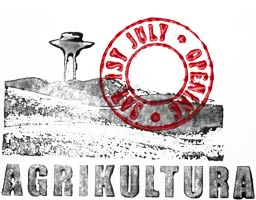Villages in southern Sweden were founded on agriculture. The mill, the dairy, the smithy, the bakery and the general store – all supporting or directly related to the land. The landscape then, was a network that emanated from these engines of utility.
The connection to the land is not altogether lost. Sweden industrialized late, so many families still have a link to a farmhouse that became a summer cottage. The Swedish summer culminates in the brightest holiday of the year, midsummer – the summer solstice – a time to celebrate, to eat and drink off the land and sea. The allotment garden is a desire for the cottage. Roses flower beside vegetable patches, strawberries and apple trees beside anemone and honeysuckle. The larger lots contain proud micro-cottages that some, during the summer months, even live in.
Hyllie is full with allotment gardens, but Hyllie is a conundrum. Located in the flattest land, Söderslätt, with the best agricultural earth in Sweden, the city of Malmo extends and dovetails with its fields. “Landskapsstaden”, or the Landscape City, becomes a taut strategy of merging the most fertile land on earth with high density urbanism. “The good earth” (den goda jorden) is 5 minutes from Copenhagen International Airport. The vertical mall and the jogging track intersect with fields of rare Class 10 arable land.
For our next exhibition we propose tackling this agricultural legacy. As in the past two Triennal exhibitions, we will invite up to 30 artists, from Scandinavia and abroad, to propose installations, sound art and performance on the theme of Agrikultura. Specifically the exhibition will ask: what is our present relationship to the land? How can we augment and redefine our cultural and emotional connection to a nature that we have over-extended? How can we re-engage with a nature we have pushed ever further from our lives?
The exhibition will take place in Hyllie in July and August of 2017. The City of Malmö has agreed to locate the exhibition on 8 hectares of the future “English Park” in Hyllie. The opening will be held in the open with food grown in the area, and the meal itself will be designed and realized by artists, where local food producers, chefs and artists work collaboratively to develop a performative festive feast. As Maja Kuzmanovic, from the Brussels based art collective [FoAM] has written: “Food is so much more than just a biological fuel. As a communal lubricant, food is one of the oldest cultural products, a symbol of hospitality and sharing. Over the entire planet, food rituals bring people together in gracious dances of giving and accepting, from simple family meals to festive banquets.”
Unlike a conventional exhibition, Agrikultura will not take place indoors, but rather installations, land art projects, performances, mobile kitchens, formal and informal gatherings will take place in fields and in public space. The work will range from a robot that grows hedgerows as a large landscape “painting”, to a floating food forest; from participatory performances that imagine the future of our food systems to projection mapping projects that re-imagine agricultural landscapes; from bioremediation gardens, to hybridized fruit trees that grow stone fruit that blossom in variegated tones, bear a multitude of fruit, and preserve heirloom varieties that are no longer commercially available. The Triennial will also stage several celebratory meals which, as for the idea of a Symposium in ancient Greek times, include intellectual and philosophical conversation over wine.
Artists will work closely with local community members as well as working collectively. Residencies and workshops are integral to the program and opportunities for collaboration and exchange will be critical. Our goal and experience is to build networks of communities of interest in order to ensure ongoing relationships beyond the event itself.
Agrikultura will be curated by Amanda McDonald Crowley and Marek Walczak. Crowley is a NYC based curator who creates contemporary art and new media events that encourage cross-disciplinary practice and who has recently been specializing in projects that deal with art, food and agriculture. An Australian native, she has previously lived and worked in Helsinki.
Please contact us for more information.
